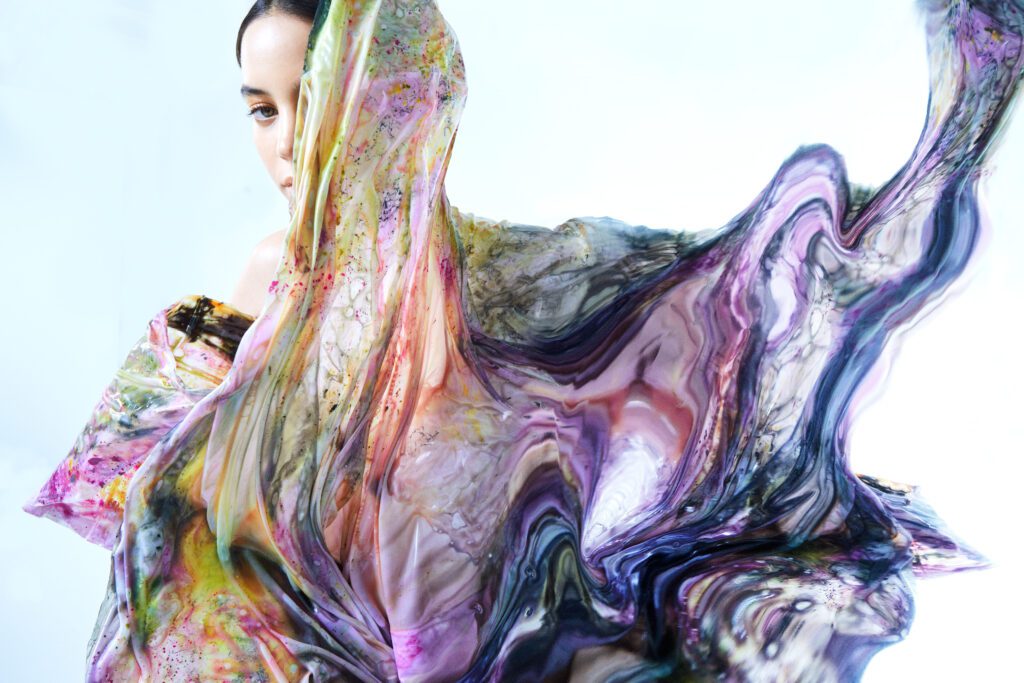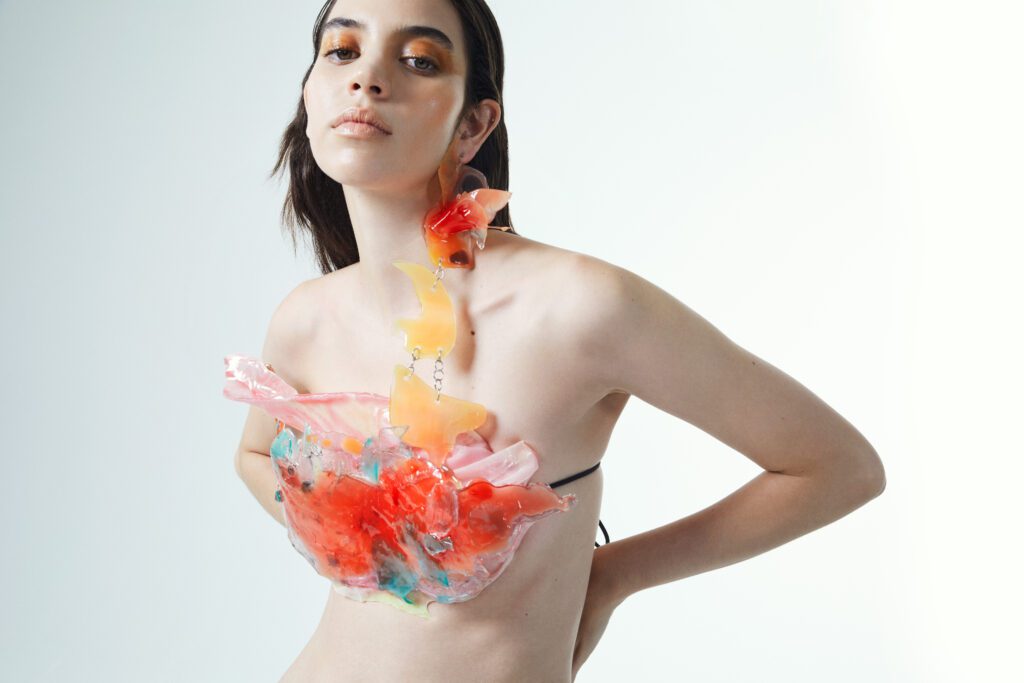
“I don’t consider myself a fashion designer,” says Kim Mesches. “I consider myself a multidisciplinary artist.”
And indeed, Mesches’ creations transcend the unspoken rules or bounds of what fashion can be: When wearing a Mesches piece, the wearer becomes an extension of the art. Every creation stands in as a symbol of the resilience and strength of humanity, and the unique ability we possess to constantly recreate ourselves — reinventing our outward-facing personas by shapeshifting sartorially.
Mesches’ designs have been commissioned by stars Normani, Cardi B, Noah Cyrus and more. Informed by the avant-garde couture designers and expressive visual artists that paved the way for his interdisciplinary practice — Iris Van Herpen, Rick Owens, Alexander McQueen — each of his pieces represents our capacity to metamorphose, like a caterpillar morphing into a butterfly. And this is exactly what his latest collection, Collection 5, is all about.

Courtesy of Kim Mesches
Brooklyn Magazine sat down with Mesches after he launched Collection 5 in March to speak about his divergent artistic approach and the new chapter this range signals for collections to come.
You studied fashion and you come from a family with creative backgrounds. How did creativity play a role in your early life and what led you to fashion design?
I started sketching clothes and drawing at a very young age. I would make clothes for my Beanie Babies, then I started drawing on clothes and making t-shirts and things. In high school, I used to have a little business where I graffitied sneakers. I wore my own around school and people were asking, “Where are those from?” I developed it a bit and started doing it for other people. I eventually moved to New York after dropping out of American University; it was just not my vibe. I applied to FIT and ended up getting an internship off of Craigslist with a designer named Anne Bowen who was big in the early 2000s. I joined her team around 2009. She was a high-end evening wear designer and I walked into her office with a portfolio full of graffiti sneakers [Laughs]. I worked there for four years and I was head designer at the brand by age 23. And then I’ve always liked to draw and paint. I’ve always experimented with different mediums. After that, I got more into styling, which is sort of what I’ve been doing up until now.
Maybe it stems from your grandfather being a visual artist, but you effortlessly blend the worlds of art and fashion through your pieces. I’m drawn to designers whose work spans more than one world. Why is that the sweet spot that your practice leans toward?
I got into fashion in the first place because of couture designers and the people who create art. These designers were utilizing not just commercialized silhouettes over and over again, but they could create garments that were sculptures, like Iris Van Herpen and early [Alexander] McQueen. Those people were very inspirational to me, along with my grandfather. It’s just where I landed at this moment. It’s been a long journey of experimentation. I make things that happen to be wearable, but they’re more sculpture-based, first and foremost. It’s really fun to bring the art back into fashion.
There are a lot of aspects of the industry that have gotten away from that original heart of it all. So when I see people who still perceive fashion as wearable art — which it totally is — I think that’s really cool.
I’m trying to expand the pigeonhole of what it can mean to be a designer because when I shot my collections, I shot them on-figure and off-figure. So I put the pieces on the wall. I offer them as interior pieces as well, and I do custom things for people’s homes. I want the pieces to have no end to them. I want them to feel like they could be anything. You can turn them into a piece of furniture or make lighting out of them. That freedom excites me.
I also think that framing garments to consumers in this way helps people place more value on the things that they wear. That’s so important in a world where so many things are produced so quickly and they don’t have that artistic intention behind them.
Exactly. My fourth collection was all upcycled pieces from my last three collections. All the fabrics that were used were from my studio — failed prototypes that had just been sitting. Some of the collection even included my grandfather’s sketches.
Who or what are some artists, designers, or brands that you enjoyed when you were growing up that now inform your brand?
I was truly obsessed with McQueen. He was my first intro to couture fashion. It blew my mind to see his designs. The collection that really stuck with me was called “The Horn of Plenty.” I thought it was so dark and twisted and sexy and dangerous. These are all things that I bring to my aesthetic. I want things to feel a little bit dangerous, sharp, organic, toxic, and poisonous — but really beautiful. Rick Owens is always a huge inspiration of mine. Iris van Herpen — her creativity, in general, is just beyond anything I’ve ever seen. As far as artists, I love Franz Klein, who is an artist who loves super graphically beautiful paintings.
One of the first things I noticed about your new collection was the influence of organic gestural movement. There’s an evident allusion to nature and the natural world. Are you often inspired by nature?
I’m always inspired by anything in the ocean. I’m a huge ocean person. I tried to be a marine biologist — that did not work. But I just love looking at the ocean. I’ve always been inspired by organic anything. Many of the pieces in this collection are heat-activated, so they change color, which is fun to play with. Those pieces are very inspired by bioluminescence.

Courtesy of Kim Mesches
The main theme of the collection is the dramatic metamorphosis that caterpillars undergo when transforming into their final form. How do you feel that your creative outlook has evolved since those earlier days?
I think everything has been a stepping stone to this voice I’ve developed now. There are a lot of influences from all of my backgrounds that are very present in the work that I’ve been currently producing. Even when I was styling, I was doing my own editorials with a bunch of really talented photographers and we would just take things and try and make stuff out of silicone or plastic. That experimentation informs my work now. This collection was really fun to create because it’s done in three parts. It evolved organically. The first part is all white and natural materials. The whole process was pretty experimental; it’s always a fun challenge.
I want to dive deeper into those three parts. What part of the story does each represent and then how do you relate to that story as well?
I think the collection is not necessarily only about nature. It’s just about human interaction and human development in general. When we’re young and trying things out, it’s very innocent and feels very curious. Then the world hits you and it becomes a little darker, more real, and you become a fully realized human yourself. That’s been my journey, which I think is everyone’s journey, in one way or another. When I was just starting, everything was possible. Then things get harder and you need to find your own flow and find your voice. I think that’s a message that everyone can relate to. I wanted the first part to feel very hopeful. Beautiful. And then the next part to feel dark, dangerous, and sexy. And then the third part should feel very wholly realized and unafraid. There are the brighter colors and it’s kind of an explosion.

Photo by Kim Mesches
In your collection notes, you say you wanted to inspire a sense of curiosity in wearers. How do you hope that the pieces make people feel? Or what questions do you hope people ask when they see the pieces?
I want all of the work to challenge human perception and make people a little confused and curious in terms of, ‘How is that done? Where does the body end and where does the piece start?”’ I want people to be very enthralled by it, but confused by it. And when someone’s wearing my designs, I want them to feel like a powerful underwater space creature or something. I want them to know that they’re a walking work of art.
Sometimes the question I just asked can be a tricky one for artists because you don’t want to tell someone how your work is “supposed” to make them feel. But I think when it comes to fashion, that’s kind of the buy-in. It’s like, “I want to be a person who wears this brand because I want to feel powerful and I want to look powerful.” And I think your pieces do that. They invite people in.
I want it to transcend the boundaries of fashion too — when people have it in their houses, I want the same reaction. I want people to be like, “Wait, that piece on your wall, how is that even done?”
How does your neighborhood inspire you? How does the creative scene in Brooklyn propel what you do day to day?
I’ve been in Brooklyn since 2009 and it has always been very raw and inspiring. Just the setting itself, walking around is always inspiring. Especially in Bushwick. My neighborhood is always peaceful and I love the people watching. There are so many creatives in all of these loft buildings doing their own things. It’s fun to be around like-minded people.
How do you plan to continue building up from these foundations and what do you hope to work on next?
My goal is to open a design studio. I want to be able to expand my practice into other cross-industrial practices. So I want to work with different companies, collaborating on lighting, and working with other interior companies to do more pieces for private collections. I want to put everything into one umbrella and have a larger space to do that. I plan to keep making pieces. I make a lot of custom pieces. But the dream is to open a design studio that can bring everything into one place. I assume it would be in Greenpoint or Bushwick. That seems appropriate.
The post Don’t call Kim Mesches a fashion designer appeared first on Brooklyn Magazine.

